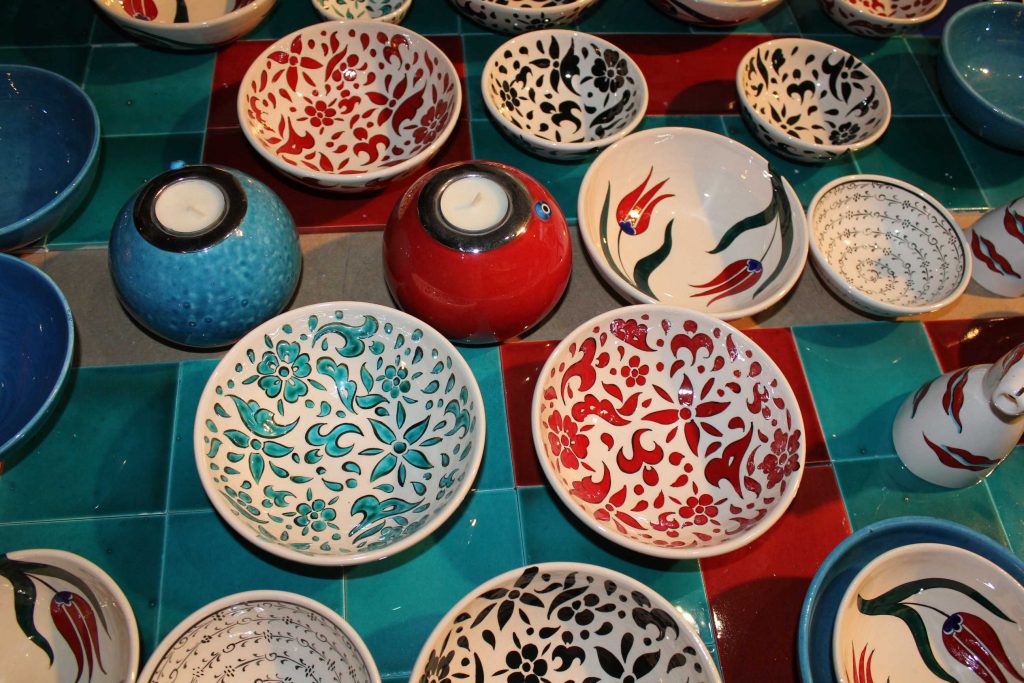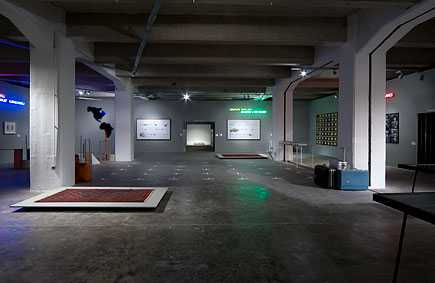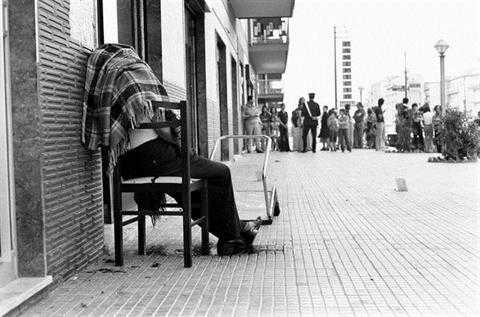Istanbul Biennial
THE BIENNIAL AS CURATORIUM
by Patricia Watts
Share |
This year’s 12th edition of the Istanbul Biennial (Sept. 17-Nov. 13, 2011), designated “Untitled,” is likely to disappoint — that is, if you are looking for what we might expect from a biennial: a large, open-ended survey of recent global contemporary art. What you will see instead is actually akin to a museum exhibition, a focused, thematic and interpreted group of artworks — a curatorium, if you will — and as such, it is a bold (if problematic) move on the part of co-curators Jens Hoffman, director of San Francisco’s Wattis Institute for Contemporary Art, and Adriano Pedrosa, an independent curator based in São Paulo.
The show these curators did assemble can be seen, when considered on its own terms, as intellectually rigorous and provocative. Yet, presented as a biennial, it comes across as a highly confining exhibition experience with thematic narratives structured around the work of a deceased artist — Felix Gonzalez-Torres — who is not even included the exhibition. What? This “ghost in the shadows” approach does not leave much room for the “open interpretation” that the curators themselves have stated as their goal for the biennial.
The show draws attention to its own exhibition design, by the architectural office of Ryue Nishizawa in Japan, a nicely done series of white-box viewing spaces, stretching into the distance, each room separated from the other and wrapped with an exterior of corrugated steel siding. The Istanbul Biennial has over 50 solo presentations and five group exhibitions in two buildings at one location — Antrepo on the waterfront in Karaköy and, next door to it, the Istanbul Modern.
As I’ve mentioned, this non-biennial is structured around concepts and esthetics embodied in the work of Cuban American Felix Gonzalez-Torres (1957–1996), and the curators have named the five group exhibitions, with titles such as “Untitled (Death by Gun)”and “Untitled (Passport),”after particular artworks of his, with their themes of gay love, sexuality and loss, and the critical and creative possibilities for understanding history.
Even if you are familiar with the work of Gonzalez-Torres (who was included posthumously in the 1997 Istanbul Biennial), you might wonder: Why? Why him? And how does using his work as a point of reference illuminate today’s contemporary art practices?
Just the same (considering the show we have rather than one we might expect), the curators have used the framework of Gonzales-Torres’ work quite effectively as a lens to focus on Latin American, Eastern European and Middle Eastern artists with an emphasis on the political (social, geographical, cultural). Through this means, they have created a curious, and even haunting, departure from the biennial format that leads the viewer on a poetic treasure hunt for some important historical artworks, by Tina Modotti, Martha Rosler, Elizabeth Catlett and Chris Burden, among others.
As for our expectation that a biennial will give us a cross section of cutting-edge contemporary art, approximately 20 of the installations were commissioned specifically for this edition. But at least 30 works were made before 1999, and some pieces have already been seen in other biennials of recent and not-so-recent years. Newell Harry’s Untitled (Gift Mats) in the 2010 Sydney Biennial, for instance, and Catherine Opie’s Surfers in the 2004 Whitney Biennial.
And as for our expectation of a global representation, the show includes no Chinese artists, only one East Asian, and a handful of Americans. So this homage exhibition was really designed, instead, to showcase artworks with esthetic strategies similar to those used by Gonzalez-Torres — minimalist and poetic works, a love story, a memorial and works that incorporate his noted takeaways.
Rather than discussing art from within the framework that the curators have imposed on viewers, I am simply going to summarize some of my favorites, biennial style.
New kid on the block from Belgrade, Serbia (schooled in the U.S. and now teaching photography at Tennessee’s Vanderbilt University), is Vesna Pavlovic. Her installation Search for Landscapes (2011), commissioned for the biennial, is an anthropological study presented as a vintage slide show. With multiple screens and projectors, the work cycles through images from one family’s travels around the world in the 1960s — using a recently outdated medium to examine historic landscapes from the period of its mass popularity.
The show features several other collections or ephemera-based works, including Hungarian artists Tamás Kaszás and Anikó Loránt’s Broadband Bulletin Board (1998–2009), a wooden structure housing broadsides, drawings and videos of propaganda espousing a bohemian utopian lifestyle. Also, Historical Records Archives (2005–ongoing), assembled by Israeli artist Dani Gal, is a collection of vinyl record albums presented as objects (no sound), including political speeches and other historical events with orations by Martin Luther King, JFK, Hitler and Lenin.
Los Angeles artist Mungo Thomson‘s 2010 video Untitled (TIME) encapsulates history in a rapid sequence of all the covers of Time magazine from 1923 to 2010. A century passes by your eyes in two minutes in this compressed succession of famous people and world leaders. And, from Istanbul, Ali Kazma‘s video O.K. (2010) captures a government clerk fiercely stamping documents with such intensity and speed that time and space themselves seem to be distorted.
Perhaps the most provocative work in the biennial is Egyptian artist Wael Shawky’s Cabaret Crusades: The Horror Show File (2010). This 30-minute video, made with 200-year-old marionettes from the Lupi Collection in Turin, gives us the story of the First Crusade of 1096–1099, a military expedition by western Christianity to regain the Holy Lands, told from the perspectives of Arab historians in Arabic with English subtitles. The film opens with a scene of the plague in Constantinople and goes on to display the bloody battles and civilian massacres, showing us religious war from a peasant’s perspective. The antique marionettes, dressed as Christians and Muslims, present a story that is evocative and telling — a horror show of subjugation despite the beauty of the handcrafted figures, filmic lighting and sets.
Two other impressive war-related works include Ala Younis’ Tin Soldiers (2010–11) and Kristen Morgin’s The Third Day of May (2011). Younis, who lives in Amman, Jordan, and was born in Kuwait City, presents, on top of a massive table, 12,235 custom-made tin soldiers, produced in numbers proportional to the numbers of active troops in 2010. The soldiers are re-creations of toys that children of noble households are given to prepare them for future rule, fitted with military outfits of Egypt, Lebanon, Iraq, Iran, Israel, Jordan, Palestine, Syria and Turkey. This work brings home the scale of current militarization in the Arab World.
The Los Angeles-based Morgin, by contrast, makes her own hand-sculpted and painted clay figurines and constructs 3D version of the famous 1814 painting by Francisco Goya of the execution of a Spanish citizen near Madrid. With equal impact, both works address war and death by gun from a childlike perspective.
Afghan (Black and Red) of 2009 by Mona Hatoum, the Palestinian sculptor and installation artist who lives in Berlin and London, transforms an afghan rug by cutting out threads in the shape of the Peters Project world map, introduced in 1973 to render a round world on a flat surface, giving a new world view. New York artist Hank Willis Thomas, who lives in Paris, presented I Am a Man, addressing identity politics and referencing the U.S. Constitution, which in 1787, during the slavery era, deemed the African American essentially three-fifths of a man for tax purposes. Included were twenty small paintings with statements like: I AM A MAN, A MAN I AM, WHAT A MAN, I AM YOUR MAN, I AM HUMAN.
One work, created in honor of Felix Gonzalez-Torres by Turkish artist Ahmet Öǧüt, who lives in Amsterdam, is Perfect Lovers (2008). The artist presents two coins (a euro and a Turkish coin) as precious objects in a vitrine on black velvet, like social readymades. While almost identical formally, the coins have different monetary values. The work mimics Gonzalez-Torres’ artwork (of the same title) that presents two wall clocks working in perfect unison. Both artists highlight the potential contrasts between two seemingly similar realities.
The most oddly sited work in the show was the multi-part deconstructive fencing that appeared in a few locations, both inside and outside the white cubes, in both buildings on separate floors. Unlabeled and providing an esthetic demarcation, the fences appeared to constitute a carelessly placed and inappropriate exhibition design feature. Yet, after further investigation, I learned that that the wood, wire and cement barriers were Rivane Neuenschwander’s work At a Certain Distance (Public Barriers) (2010). What a relief — rather than intrusive and ill-placed exhibition elements, they turned out to be interesting and intentionally disruptive interventions.
The show also boasts a potentially dangerous interactive work by Brazilian artist Renata Lucas, entitled Falha (Failure) (2003–11), which at first appeared like an exhibit at a children’s museum. This wall-to-wall large room installation was an obstacle course of hinged plywood sheets with handles, designed to be lifted and lowered, thereby allowing visitors to reconfigure the space. These metaphorical portals, which were almost impossible to move without potentially hurting yourself, seemed awkwardly appropriate for its given title.
Another oddity is Cuban artist Wilfredo Prieto’s Politically Correct (2009), a minimalist cubed watermelon sitting on the floor seeping juices. The sculpture seems discourteous to the biennial staff, which has to replace it almost daily and deal with any insects or animals it might attract. But I suppose it references Gonzales-Torres’ celebrated candy spills, in which cellophane-wrapped sweets are neatly piled in the corner or spread out on the floor of the gallery. Both works definitely exemplify the transformation of the everyday into a meditation on love and loss, figuratively and literally. The ghost of F.G.T. lives on.
Overall it was a thoughtful and methodically crafted exhibition. The works were both esthetically and politically engaging. Complicated, yes. Was it a traditional biennial? No. But it does have enough new work from an international representation of artists to keep a visitor interested. And, an added bonus — the Istanbul Biennial is sited in one of the world’s most beautiful and enduring cities, aptly known as a cradle of civilization. While viewers may find it’s organization odd, it is hard to be critical of such a sophisticated and rewarding show.
PATRICIA WATTS, an independent curator, was formerly chief curator at the Sonoma County Museum in northern California. She has been a curator for ecoartspace since 1999.
http://www.artnet.com/magazineus/features/watts/2011-istanbul-biennial.asp



